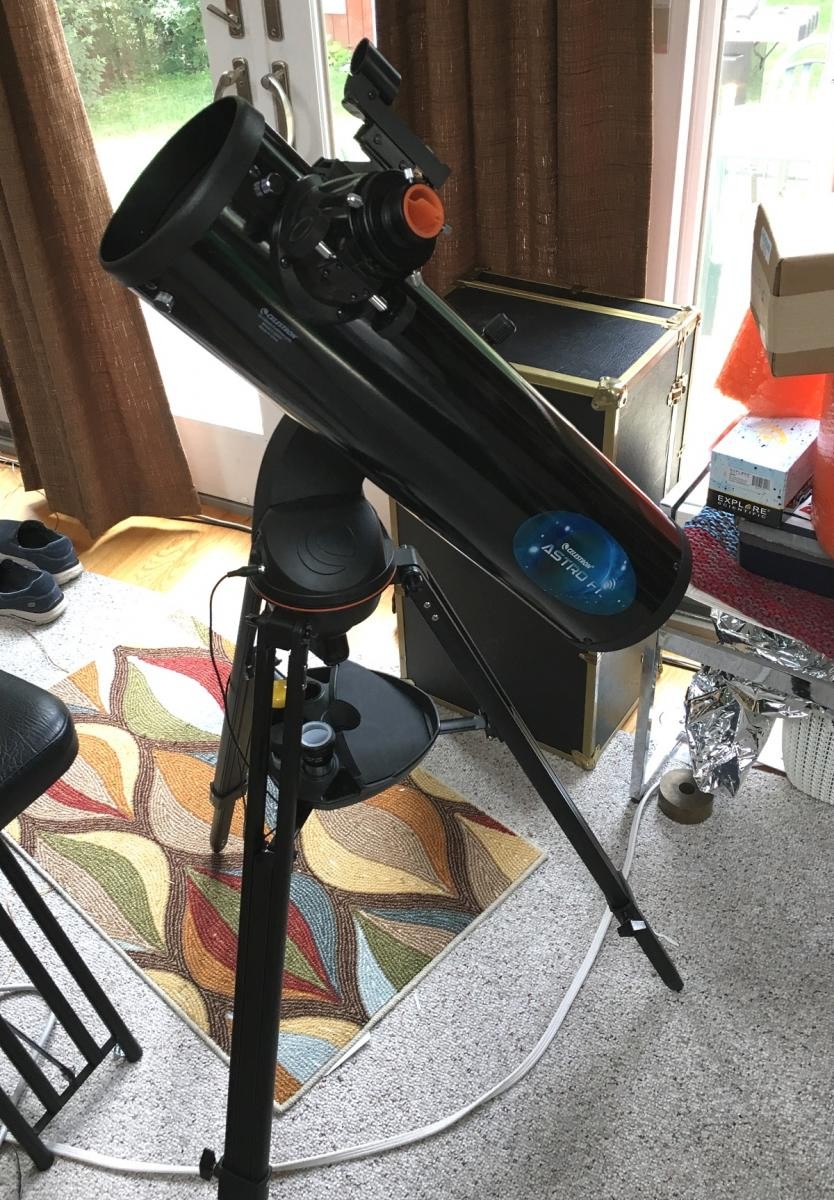

Newtonian telescopes are the most popular type of reflecting telescope, invented by Sir Isaac Newton. They use a concave parabolic primary mirror to gather and focus light and a flat secondary mirror to direct the beam of light to an eyepiece attached to the side of the tube. Some sources out there may have also informed you of Dobsonian telescopes. These consist of a Newtonian reflector on a particular design of mounting known as the Dobsonian.
Telescopes of all sorts of optical configurations—Newtonian reflector, refractor, Maksutov cassegrain, Schmidt cassegrain, e.t.c.—can be attached to a variety of different types of mountings. A mount holds the telescope and allows it to pivot, making it easier for users to track celestial objects. Different mounts have distinct advantages based on their intended use, portability, stability, and ease of tracking. Some mounts sit directly on the ground; others use tripods or piers.
When a Newtonian reflector optical is placed on a particular design of mounting known as the Dobsonian mount, it’s commonly referred to as a “Dobsonian telescope.” However, this term predominantly refers to the type of mount and not the optical design. While pretty much all Dobsonian telescopes are Newtonians (because they use the Newtonian optical design), not all Newtonian telescopes are Dobsonians, since they can be mounted on various other mount types, such as equatorial mounts or alt-azimuth mounts that aren’t Dobsonian in design. When you are shopping for a Newtonian reflecting telescope, Dobsonians are just one of the options out there – albeit the predominant and preferred choice for most apertures.
If you’re considering buying a Newtonian reflector, we predominantly recommend one integrated with a Dobsonian mount. Its blend of simplicity, stability, and ease of use makes it an ideal choice for many, especially those new to astronomy. In fact, a Dobsonian telescope is often considered one of the best choices for beginners, offering an excellent balance of performance and user-friendliness. For those eager to dive deeper into the world of stargazing and telescope choices, we encourage you to explore our “Best Telescopes” and “Best Dobsonians” guides, where we delve into specifics to help you make an informed decision tailored to your budget and requirements.
Why Are Dobsonian Mounts the Best for Newtonians?
The primary challenge in picking a mount for a Newtonian reflector arises from balance and stability. Newtonians, especially larger models, can be quite heavy at the back, where the primary mirror is located. Dobsonian mounts, with their low-center-of-gravity design, tend to be more stable and thus, are a preferred choice for Newtonian reflectors, particularly for larger Newtonians in excess of 6” or so in aperture.
The Dobsonian mount, named after its inventor, John Dobson, is one specific kind of mount designed for Newtonian telescopes. It is designed to be as cheap as possible and is particularly optimal for larger telescopes. Prior to the Dobsonian, the biggest and thus most powerful telescope an amateur astronomer could expect to afford or be able to house was an 8” or maybe 10” reflector atop a spindly German equatorial mount and a bulky pier or tripod. Today, many amateur astronomers get their start with an 8”, 10”, or even 12” Dobsonian, while scopes in the 15–25” range are common, and even a 40” is not unheard of. This is because of the Dobsonian design’s simplicity, ease of use, and cost-effectiveness.
A Dobsonian mount employs a simple alt-azimuth design, which means it can move up and down (altitude) and left and right (azimuth). This straightforward movement makes it intuitive for beginners. Dobsonians sit on the ground or atop a table rather than on a tripod or pier. They keep the center of gravity of the telescope low, which maximizes stability and minimizes height. For these reasons, as well as the low cost and complexity of construction, Dobsonian mounts are the only practical choice for a transportable 12” or larger telescope and often the only way one can accommodate or afford a telescope of such size and capability.
Can I Convert a Dobsonian Telescope to EQ-mounted?
Many larger Dobsonian telescopes are more or less integrated with their mounts; the altitude bearings are permanently affixed to the side of the tube or lower assembly, and there is often no ability to adapt the telescope to an equatorial mount—not that you’d have an easy job finding one big enough. Even if you could, such an assembly would be bulky; Newtonians over 10” or so require an observatory if they are mounted atop a typical equatorial mount and pedestal, while a well-designed 10” Dobsonian can be compacted to fit in a suitcase, and even a 30” Dobsonian fits in many vehicles.
While traditional Dobsonian mounts are manual, meaning they require hand movement to follow objects, many modern Dobsonians come equipped with automated GoTo pointing/tracking or can be placed atop an equatorial platform for tracking capabilities. These motor-driven systems can automatically follow celestial objects, making them handy for visual observations. The tracking of a GoTo Dobsonian or EQ platform is generally not as precise as on high-end equatorial mounts, but it’s sufficient for visual observation and even planetary imaging, which doesn’t demand the long exposure times and precision tracking that deep-sky imaging does.
